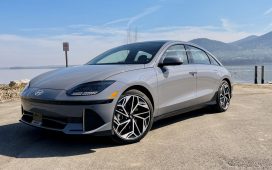Stellantis, parent company to storied brands like Chrysler, Jeep, Ram, and Dodge, said it will adopt Tesla’s electric vehicle charging plug for its future EVs — becoming the last major car company to do so.
Stellantis said its first EVs to feature the SAE J3400 plug, also known as Tesla’s North American Charging Standard, will be out in 2025. During the transition period, the company said it will provide adapters to customers who own EVs with Combined Charging Standard, or CCS, plugs.
The company sells a range of plug-in hybrid vehicles, as well as battery-electric models, most of which are available in Europe. A slate of upcoming EVs, including fully electric Jeep, Ram, and Chrysler models, are planned for the next several years.
The decision is expected to give Stellantis’ EV customers access to Tesla’s superior charging network, as well as provide some peace of mind about the future of EV charging in North America and beyond. Interestingly enough, Stellantis’ press release on the announcement makes zero mention of “Tesla,” instead referring to the company’s charging plug under its official standard name, SAE J3400.
The decision is expected to give Stellantis’ EV customers access to Tesla’s superior charging network
Things started rolling in November 2022, when Tesla announced that it was renaming its charging technology to the North American Charging Standard (NACS) and would be opening it up to other automakers. The idea was to give the rest of the industry access to its more reliable charging stations at a time when EV charging is a dicey and precarious proposition.
Ford came first, then GM, and then, well, everyone else. Most recently, Volkswagen Group — one of the world’s largest automakers, with brands like Audi, Bentley, Bugatti, Porsche, and Lamborghini under its umbrella — announced it would be adopting NACS, leaving Stellantis as the last remaining holdout.
Until just a few years ago, Tesla Superchargers were exclusive to Tesla owners. In fact, it was one of Tesla’s main selling points: consistent, exclusive, and abundant EV charging. But that began to change when the company started offering access to non-Tesla EVs — first in Europe and then in the US after the Biden administration said it would be a prerequisite to tap into some of the $7.5 billion for EV charging in the Bipartisan Infrastructure Law.
Tesla’s Supercharger network is widely recognized as superior to many of the third-party EV charging stations, most of which feature CCS plugs and the less utilized CHAdeMO charging standard. The company says it has 45,000 Superchargers worldwide, 12,000 of which are located in the US.
Stellantis, along with BMW, GM, Honda, Hyundai, Kia, and Mercedes-Benz, is involved in a joint venture to install fast-charging EV stations along major highways and in cities in the US. Today, the company said those future charging stalls would also feature Tesla’s charging plus alongside CCS outlets.












